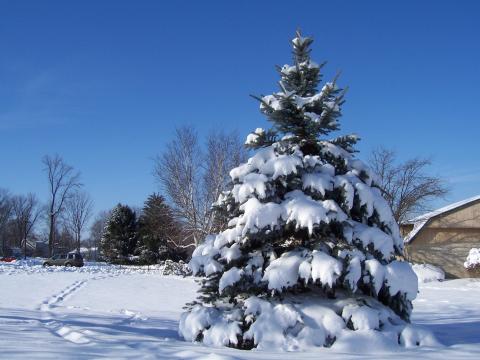Living Christmas Trees

As the holiday season approaches, you might be thinking about getting a Christmas tree. Typically, most people opt for cut trees, which can last up to a month if they are well cared for and harvested shortly before being brought into the house. You may not realize that it is possible to enjoy a living Christmas tree inside your home during the holidays, which can later be planted in the landscape. This provides a way to keep Christmas memories alive year after year, while avoid guilt over cutting down a tree that gets thrown away a few weeks later.
Choosing a tree
Success with a living tree starts with choosing the right one. Live trees can be purchased in one of two ways – container-grown or balled and burlapped. Larger trees will typically be balled and burlapped, but it is also possible to find smaller containerized plants, which are a little easier to maneuver inside of the home. If you do buy a balled and burlapped plant, leave its wrappings in place inside the home. Many evergreen species are good landscape trees in New Hampshire, such as Serbian spruce, Norway spruce, white spruce, Fraser fir, balsam fir and white fir. Garden centers and nurseries will often carry these plants during the holiday season for those interested in living trees.
Keeping a living Christmas tree inside
Try to purchase the tree a week or two before you plan to bring it inside, and stage it in an unheated space such as a shed, garage or porch to help the tree make the transition between outdoor cold and the inside of your home. While this step isn’t absolutely necessary, it can put less stress on the tree. Keep the roots moist during this time. While the tree won’t lose much water in the cold, it does need some. Live trees should only be kept indoors for 7 to 10 days. Any longer and the tree may start to lose its winter dormancy due to exposure to warmth, making it impossible to put the tree back outside after the holidays without causing injury to it.
Once inside the home, live trees should be grown like any other houseplant. Ideally, the tree should be placed in a cooler area away from heat sources (i.e. away from vents, woodstove or fireplace), and LED or low temperature lights should be used for decorating. Equally important is regular watering, allowing the soil to dry out between watering. To avoid making a mess, place the tree inside of a large leak-proof pot or tub that will collect excess water. Place a few stones or a board beneath the root ball of the tree to keep it from sitting in standing water – a situation that can be deadly for evergreens.
What to do after the holidays
Don’t plan to plant your Christmas tree immediately after the holidays. Even if it is possible to dig a hole for it, the tree is unlikely to survive if planted so late in the season. Instead, move it to an unheated structure for the rest of the winter and check to see if it needs water periodically. If you don’t have a cool garage or shed, place the tree in a protected spot out of prevailing winter winds and mulch the root system.
Living Christmas trees can be planted outside in the spring once the soil has thoroughly thawed and dried. Make sure to research how tall your tree has the potential to grow. Most popular Christmas tree species will reach between 30 and 50 feet at maturity.
No room for a large tree?
If you don’t have room for a full-sized live Christmas tree, a living tabletop tree is a possibility. Dwarf Alberta spruce (Picea glauca) is a hardy shrub that is popular in formal landscapes. It naturally grows upright in a conical shape and is perfect as a miniature Christmas tree. Like other full-size trees, it should only be kept indoors for a short amount of time, and planted in the spring.
A few indoor plants can also be good alternatives, such as Norfolk Island pine (Araucaria heterphylla). Norfolk Island pine is a tropical evergreen that is fairly easy to grow indoors. When placed in a spot with bright, indirect light from an eastern or western window and given consistent soil moisture, plants can live for many years. The main downside is that the branches are too weak to support most ornaments. Other indoor possibilities include lemon cypress (Cupressus macrocarpa) and Rosemary, both of which can be brought outside in the summer.
Got questions? The Ask UNH Extension Infoline offers practical help finding answers for your home, yard, and garden questions. Call toll free at 1-877-398-4769, Monday to Friday, 9 a.m. to 2 p.m., or e-mail us at answers@unh.edu.
Related Resource(s)
Do you love learning about stuff like this?
SUBSCRIBE TO Granite State Gardening newsletter
Got questions? The UNH Extension Yard and Garden Infoline offers practical help finding answers for your yard and garden questions.
Call toll free at 1-877-398-4769, Monday to Friday, 9 a.m. to 2 p.m., or fill out webform.
